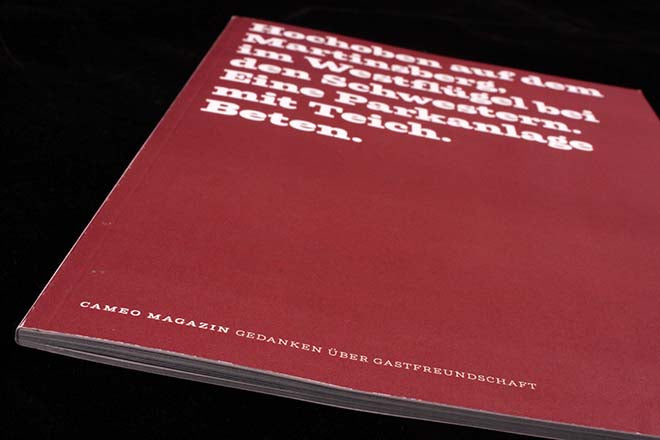
Cameo
When choosing our Magazines of the Week we look for a combination of editorial cohesion and impeccable design, but we also look for a hint of intrigue, something particularly special that captures our imagination. Cameo is not our usual choice of Magazine of the Week, yet it is our Magazine of the Week today – that’s because it is very much of this week, or month, or year, and also because it has that intriguing knack for visual and written storytelling that we love to champion.

Originally created by two photo-journalism students from Hanover, Cameo has been recording and documenting the lives of refugees in Germany since its first issue last year. The topic of refugees is timely, but it should also be more than timely because building a relationship with refugees needs on-going attention after the media spotlight has dimmed. Cameo is attentive and investigates the lives of refugees in Germany – it has been doing so before the news cameras arrived and it will be continuing to do so long after the news cameras are gone.

Co-editor Julius Matuschik tells me that Cameo first began when he and co-founder Sebastian Cunitz went to Aachen to photograph refugees living in the German border town. Most of the orphanages there are overfilled, so much so that 30% of the young refugees have been put up in hotels. The conditions of the hotels are good, but as Julius told me, there aren’t any schools or jobs and there is nothing to do – the atmosphere is intensely isolating, boring, alienating and lonely. ‘We found that we couldn’t transport everything we felt and saw and heard in photographs alone,’ Julius explains, ‘There had to be some other vehicle to convey what was happening. That’s when some of the young boys said “we can write letters to you” and the idea for Cameo magazine first came about.’

The content of Cameo is made up of letters from refugees Julius and his team have met while taking photos at their housing facilities. The first issue features letters from boys living in Hotel Aachen (“there are no girls because the passage to Europe is deemed too dangerous,” Julius explains) as well as photographs taken by Julius and Sebastian.

For the covers of issue one and two, Cameo have used a simple, typographic cover. Issue one’s cover translates as: ‘Bath or shower, WC, telephone, internet, cable TV, minibar, terrace with balcony. Waiting.’ Most of the letter writers describe this set up as the entirety of their present existence, and the photographs candidly capture the atmosphere of stillness, of waiting and delay. The cover of issue two (above) describes the surroundings of the small village where the issue’s letters come from.

The letters are printed on one page of the glossy publication (several written in English), and on the other side is Cameo’s translation of the text in German (above). ‘It felt important to have the physical letters printed inside,’ says Julius, ‘That way the reader can sense what the person writing the letter is like; hints of their personality are conveyed in the shape and curve of the handwriting.’

The idea to bring the letters together in the form of a magazine felt right – at first, Cameo Collective briefly considered an exhibition or a hardback art book, but a magazine is compact, transportable, personal, inexpensive and also crucially easy to pass around. ‘There is a lot of racism in Germany, and we wanted to show another image of the refugees – to create empathy and understanding.’ A magazine seemed perfect because it exchanges hands quickly, yet it is more personal than a website which also travels fast. The combination of stark photography and very personal letters gives Cameo a fresh, considered and unique perspective, a powerful perspective that is very rarely heard.

The second issue of Cameo featured people – all given complete anonymity in the portraits– living in another refugee accommodation site, this time a converted cloister in South Germany. The theme of the issue was ‘hospitality’, and it considered German’s culture of welcoming as well as the deep-rooted religious tradition of hospitality. Many of the letters express a sense of loneliness and describe attempts at making friends at local bars or cafes – ‘at the time, there was no dialogue between the communities’, explains Julius, who sees a significant, and hopefully permanent, change since the Syrian refugee crisis has been broadcast so widely on the news.

There has been a huge amount of coverage about Germany – and Europe’s – current refugee intake, and Cameo sets out to continue covering the arrival of refugees from around the world, to document their continued stories in this personal, letter-format, using a magazine to build bridges and make connections. Whilst some news sources might drift elsewhere, Cameo will stay with the stories and it also aims to find new, surprising ways of telling it.

Cameo is our Magazine of the Week this week in the sense that it is absolutely what you should be reading – not just this week, but next week, and the week after that too.


